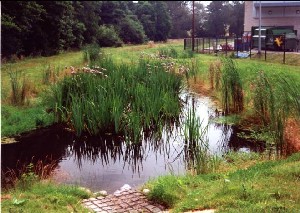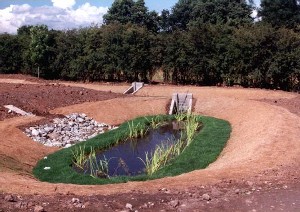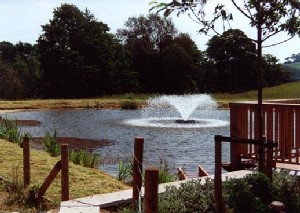Where
Location
The Hopwood Park motorway service area (MSA) is situated at Junction 2, on the M42, where the A441 crosses the motorway.
Description
The MSA comprises an amenity building surrounded by car parking, coach parking and a dedicated HGV park with a centrally located fuel filling area. The MSA is enclosed in a series of planted banks and falls northwards to the Hopwood Stream which flows eventually to the River Arrow.
The site comprises 34 hectares of which 9 hectares is the MSA and 25 hectares a wildlife reserve. A stormwater ditch draining the adjacent A441 divides the MSA into 2 sub-catchments, the HGV Park and the remainder of the MSA.
SuDS used
The concept of the management train has been used at Hopwood Park MSA with a variety of SuDS components in series to improve the flow and quality of runoff in stages prior to release into the local watercourse.
Each part of the site collects runoff in a different way but treats the 10mm first flush in stone treatment trenches where possible, a conventional grit / oil separator to the coach park and fuel filling area with roof water directly to a feature pond from the amenity building.
How it works
|
|
|
Figure 1 Spillage basin newly constructed (Bob Bray) |
The HGV lorry park
-
water is collected across a grass filter strip to trap silt
-
10mm first flush runoff enters a stone collector trench which treats oils and other pollutants naturally
-
a spillage basin with wetland treatment zone and outlet valve isolates any spillage event
-
heavy rain passes across the trench into a grass swale
-
balancing pond 1 with marginal wetland treatment zone receives all water before release into the wildlife reserve wetland.
Main access road, fuel filling area and coach park
-
a proprietary silt and oil interceptor begins treatment to runoff which has been collected by conventional gully and pipe drainage

Figure 2 Constructed wetland (Bob Bray)
-
2 spillage basins with wetland treatment zones and outlet valves isolate any spillage event
-
a constructed wetland cleans 10mm first flush runoff with an additional outlet valve to isolate any spillage event
-
a wetland ditch, receiving water at a controlled rate to prevent erosion, conveys treated first flush runoff to balancing pond 2 with a marginal wetland treatment zone
-
a bypass swale collects storm overflow and conveys it parallel to the ditch over the rip-rap cascade into the pond
-
balancing pond 2 and treatment wetland receives all water as the last link in the management train before release to the stilling area and the Hopwood stream.
Car Park
-
a sub-surface collector trench treats the10mm first flush runoff
-
a bypass channel conveys excess stormwater directly to the pond
-
a pipe outlet delivers all runoff to balancing pond 3 and marginal wetland treatment zone before release to the stilling area and the Hopwood stream.
|
|
|
Figure 3 Feature pond receiving roof water (Bob Bray) |
Amenity buildings
-
clean water is piped directly from the roof to a feature balancing pond with marginal wetland planting.
-
a cascade, controlled by a slot weir, falls to the stilling area before it flows to the Hopwood stream.
All balancing ponds discharge through flow controls to the stilling area and clean water flows into the Hopwood stream at a greenfield rate of runoff.
The SuDS management train concept
Areas considered to pose a pollution risk to the environment have used the management train concept in full to ensure good water quality and to deal with unforeseen spillage events.
The HGV park and the fuel filling area, coach park and service yard pose a serious pollution risk and have an extended management train.
The car park and amenity building roof water were considered less likely to cause pollution and therefore have progressively shorter treatment systems although the concept is applied generally to provide insurance against unforeseen spillage events.
Specific details
The MSA was designed to meet a 1 in 25 storm return period and greenfield runoff rate of 5L / sec / hectare.
Runoff from the HGV park is directed to a tributary of the Hopwood Stream via the Wildlife Reserve to enhance a pre-existing wetland and help sustain base flow in the watercourse.
Open wetland systems are protected by pretreatment features including filter strips, treatment trenches or separators to reduce pollution or silt loading and prevent catastrophic damage in the event of spillage.
Wetland basins are lined completely where designed to treat runoff or partially where a retention volume is required in the pond feature.
Design & construction
The design of Hopwood Park MSA was undertaken before the publication of the CIRIA design manuals and followed guidance from the Environment Agency and a review of stormwater management manuals from the USA. Construction was completed in 1999.
The site has been monitored since construction to evaluate performance and costs.
-
The Environment Agency has monitored the control of chemical pollution.
-
The Ponds Conservation Trust has evaluated the wildlife value of the wetland system with preliminary conclusions on SuDS effectiveness for water quality.
-
The Maintenance Costs have been reviewed by Robert Bray Associates to show benefits compared to conventional drainage.
-
Further review work has been undertaken by HR Wallingford and Edinburgh University.
Benefits & achievements
Benefit: Control of volumes and flows on site with discharge to the Hopwood Stream at greenfield runoff rates.
Benefit: SuDS techniques used in series; the management train, ensures acceptable clean water enters the natural drainage system.
Benefit: Protected wetland features to manage runoff provide a visual and wildlife resource for the site.
Benefit: The cost of drainage maintenance has been reduced, by using the Landscape Contractor to manage the site.
Benefit: The series of ponds, wetlands and low flow channels behind the Amenity building now form a SuDS walk for visitors with information boards to explain the Sustainable Drainage approach to managing rainfall on development sites.
Benefit: The SuDS features are robust and withstand damage and lack of maintenance without failure.
The information on Hopwood Park MSA M42 is provided by Robert Bray Associates, who, in association with Baxter Glayster Consulting Ltd – Consulting Engineers, designed the Sustainable Drainage System and have been responsible for arranging the management and monitoring of the site. The Client for the site was Welcome Break.





